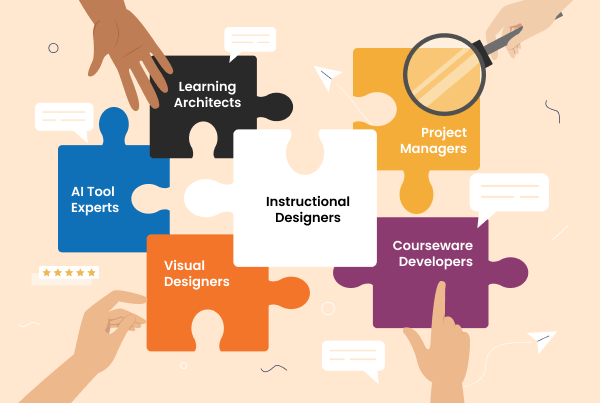Why L&D Staff Augmentation is the Superior Choice Over Outsourcing
In the fast-paced realm of corporate Learning and Development (L&D), one truth rings clear: the demands on your internal team are escalating much more swiftly than your headcount. With evolving tools, looming deadlines, shifting business priorities, and constrained budgets, L&D leaders face tough decisions. One of the crucial ones? Choosing between outsourcing learning projects and bolstering your team with additional support.
At first glance, outsourcing might appear to be the straightforward solution—handing over responsibilities to a third party for complete management. However, outsourcing eLearning isn’t always the best route, particularly when your team possesses the necessary skills, systems, and vision. More often than not, the real answer lies in staff augmentation.

Image by CommLab India
Staff augmentation empowers you to maintain control while enhancing your team’s capabilities. By integrating experts—be it Instructional Designers (IDs), visual designers, LMS administrators, or courseware developers—you can address specific needs without compromising on quality, ownership, or agility.
5 Indications That L&D Staff Augmentation is Your Best Bet
1. You Prioritize Control Over Quality and Processes
L&D transcends mere content delivery; it’s about aligning with internal processes and achieving specific performance targets. Entrusting a project to an external vendor means often relinquishing control over execution. While you may receive quality work, it might not seamlessly align with your instructional strategy or meet learner expectations.
This is particularly true when vendors resort to generic templates that fail to resonate with your organization’s culture. In contrast, staff augmentation embeds seasoned professionals within your existing framework, ensuring quality work aligned with your standards.
If your team is driven to uphold brand consistency and quality, and if frequent real-time collaboration is crucial, staff augmentation is the ideal route. It delivers the necessary oversight while ensuring instructional consistency—especially vital in industries like healthcare, finance, or compliance, where detail and precision matter immensely.
2. You Seek Specialized Expertise, Not Just Extra Hands
Many large organizations already boast talented in-house learning teams—innovative Instructional Designers, knowledgeable SMEs, and adept media developers. However, they often lack the specialized expertise required for managing complex, large-scale learning programs.
It’s not just about adding numbers; it’s about integrating high-skill professionals who bring unique expertise—from senior learning consultants well-versed in adult learning to creative designers who can bring narratives to life, and project managers skilled in global coordination.
When faced with multiple launches or when internal teams are maxed out, outsourcing an entire project might seem excessive—or even counterproductive. Staff augmentation allows you to plug in exactly the expertise you require without disrupting workflows.

Image by CommLab India
This is especially beneficial during product rollouts or compliance training, allowing you to leverage a learning strategist or graphic designer as needed—all while keeping your core team in control.
3. Your Project is Fluid, Not Set in Stone
Most outsourcing agreements demand meticulously defined scopes and timelines. But what if your project is still taking shape? If you’re pilot-testing a new LMS or reworking your onboarding process, fluidity is key. This is where staff augmentation shines.
You can swiftly onboard experts, make real-time adjustments, and shift priorities on the fly without renegotiating contracts. This adaptability is crucial when you’re experimenting or iterating based on feedback.
4. Balancing Cost Optimization and Speed is Essential
Outsourcing projects often comes with significant overheads, particularly for high-volume assignments. You bear costs for project management and facilities. But what if you only need select roles filled?
L&D staff augmentation allows you to allocate budget specifically for the skill sets you require. For instance, you might need an LMS administrator for a month or a designer for a specific project. This model facilitates quick scaling while minimizing unnecessary costs.
5. Cultivating Long-Term Capabilities Over One-Off Projects
Often, the aim isn’t solely to deliver a course or program but to fortify internal knowledge. Outsourcing may fulfill immediate needs but doesn’t enable knowledge transfer, leaving your team reliant on external support.
Utilizing staff augmentation allows your team to learn invaluable skills through collaboration, receive mentorship, and gain access to reusable templates and resources. This scaffolds internal capabilities over time.
Real-World Applications of L&D Staff Augmentation
From manufacturing to finance, organizations are leveraging staff augmentation to address critical needs. For example:
In manufacturing, teams managing extensive ERP training have added IDs and designers to support global rollouts while preserving control over messaging.
In tech and finance, augmented staff has powered innovation and system implementations, helping teams maintain agility during complex training initiatives.
Why Choose Staff Augmentation?
- Quick Ramp-Up: Experts familiar with corporate learning environments.
- System Alignment: They integrate seamlessly into your LMS and processes.
- Cultural Synergy: Collaborating closely without silos or disconnects.
- Budget Flexibility: Pay only for the specific skill sets when needed.
- Capability Development: Your team uplifts its skills through collaboration.
- Speed with Governance: Augmented staff integrates rapidly without sacrificing oversight.
Final Thoughts: Scale with Intention, Stay Adaptable
Staff augmentation isn’t just a strategy; it’s a competitive edge. If your L&D team is already excelling and merely requires the right support, augmentation provides flexibility and maintains control. This model allows you to expand capacity without sacrificing quality or inflating costs.
Your learning challenges don’t require outsourcing; they require strategic partners to enhance your team’s strengths and cultivate resilience. Ready to discover the potential of staff augmentation? Let’s connect!




